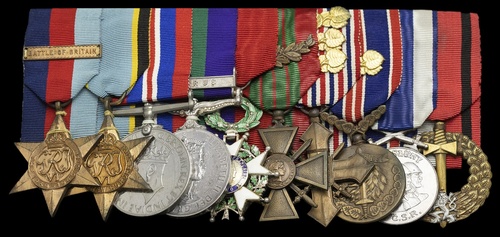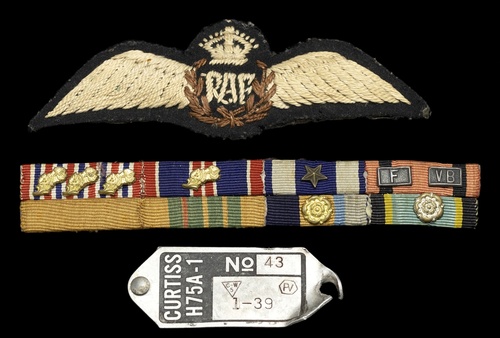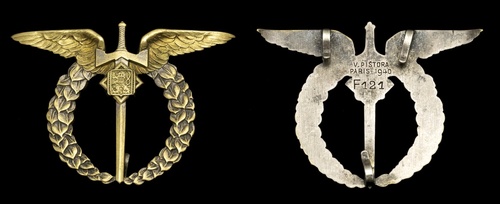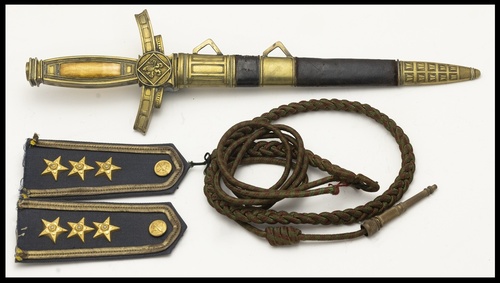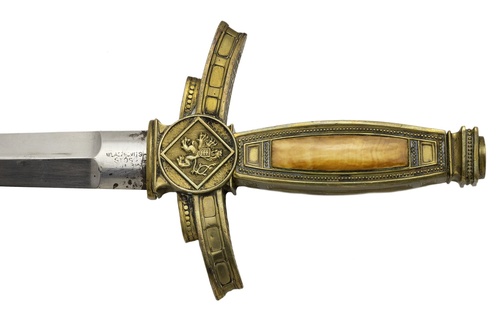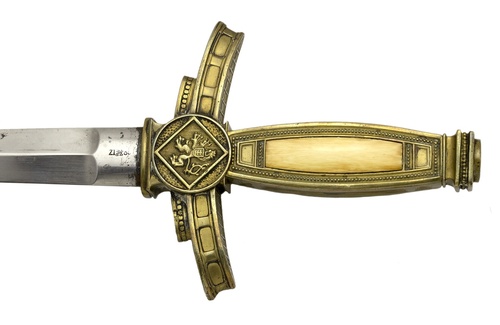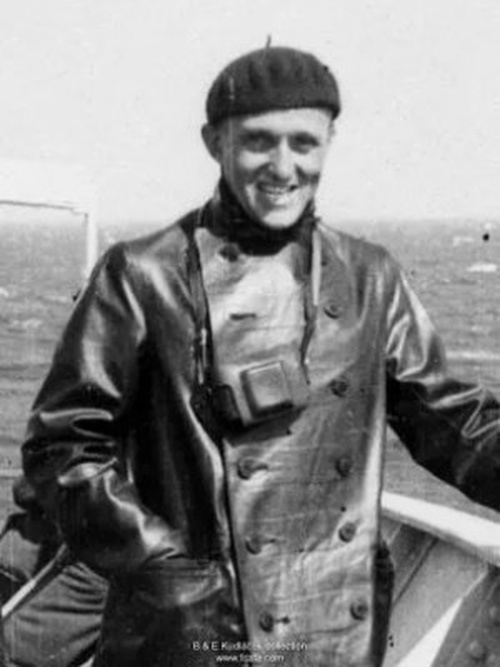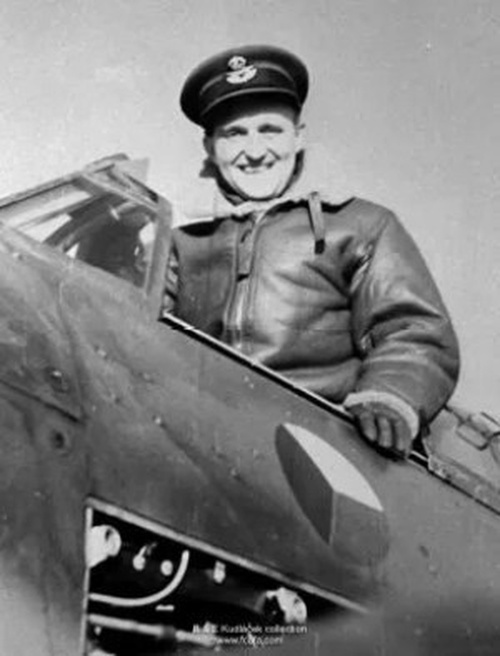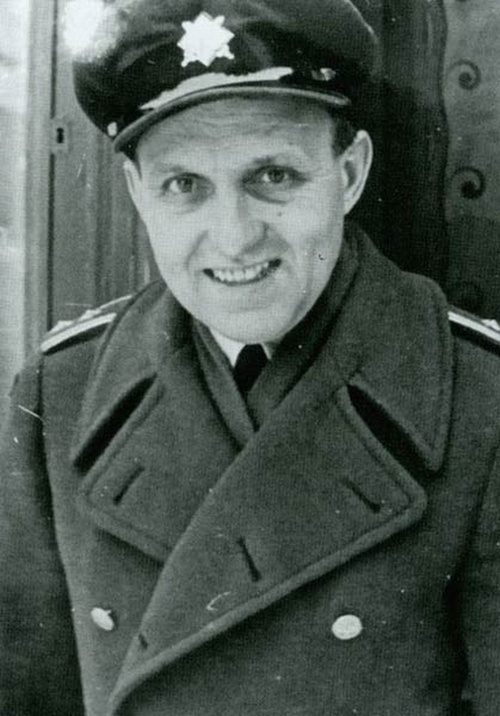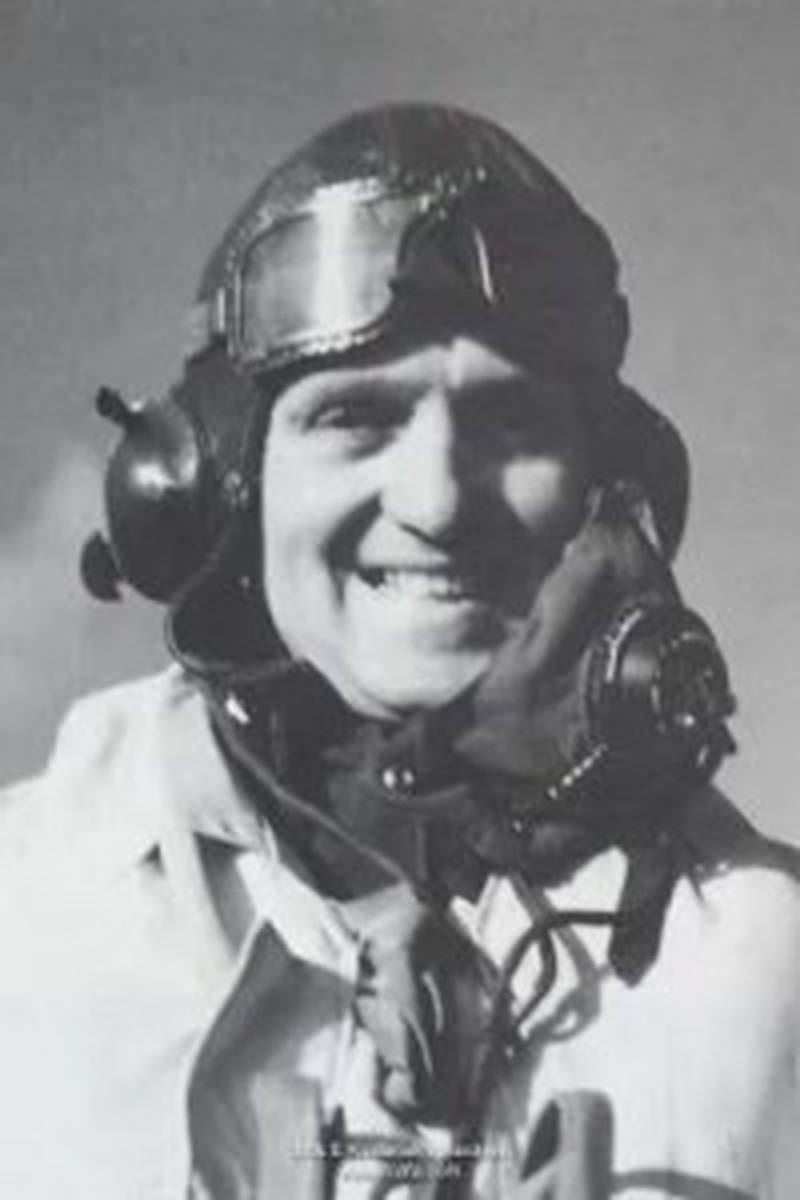Auction: 25001 - Orders, Decorations and Medals
Lot: 99
Sold by Order of a Direct Descendant
The outstanding Czech War Cross & Czech Bravery Medal group of ten awarded to Flight Lieutenant A. Vrana, Royal Air Force, late Czech Air Force and French Foreign Legion l'Armee de l'Air Groupe de Chasse 1/5
Vrana had the admirable record of one kill and two probables during the Battle of France, having then transferred to Britain, he flew in the Hurricanes of No. 312 (Czechoslovak) Squadron during the Battle of Britain as just one of just 88 Czech Pilots
1939-45 Star, clasp, Battle of Britain; Air Crew Europe Star; War Medal 1939-45; General Service 1918-62, 1 clasp, Cyprus (Flt. Lt. A. Vrana. R.A.F.); France, Republic, Legion of Honour, silver and enamel; Croix de Guerre, reverse dated '1939', with Palme upon riband; Czechoslovakia, Republic, Czechoslovak War Cross 1939, with three further Award Bars; Bravery Medal, with Second Award Bar; Military Merit Medal, silver; Army Commemorative Medal, 1st Type, mounted court-style as worn by Spink & Son, St James's, London, good very fine (10)
The Free Czechoslovak Air Force Association offer a terrific biography:
'Adolf ‘Ada’ Vrána was born at Nová Paka on 27 October 1908, the second-born son of Josef Vrána, a police officer, and his wife Františka. After completing his elementary schooling, he briefly found employment as a trainee blacksmith before changing jobs to work as a trainee mechanic at a local power station.
On reaching the age of 18, he was required to undertake his compulsory military service which commenced on 1 October 1928. He was selected to join the Czechoslovak Air Force and was assigned to the 1st T.G. Masaryk’ Air Regiment at Prague-Kbely airbase for his basic military training and training as an aircraft mechanic. On 28 February 1929, having completed this training, he was posted to the 4th Air Regiment at Hradec Králove airbase where he was an aircraft mechanic.
However Adolf’s aspiration was to fly and, having volunteered, he was selected for pilot training in August 1929. He was posted to the Military Aviation Academy at Prostejov where he successfully graduated on 1 December 1930, receiving promotion to the rank of cetar (Sergeant) on 16 December. Between 16 March and 16 May 1931, he was stationed at the Military Aviation Academy at Chleb for fighter pilot training. Successfully completing this course, he returned to the 4th Air Regiment at Hradec Králove and was assigned to the 41st Fighter Squadron as a fighter pilot.
In the years that followed, he attended further training courses including night-flying, aerial-observation and, in Boce Kotorské, Yugoslavia, seaplane training. However, Adolf realised that further development of his military career would be restricted because he had left school early without taking school-leaving examinations. To overcome this obstacle, he began a correspondence course to study for his school-leaving certificate whilst simultaneously exercising his military duties. This he achieved, enabling him to enrol at the Military Academy at Hranice in 1934. That August, whilst waiting to be interviewed by the Station Commander-in-Chief at the Academy, he met another cadet airman, Tomáš Vybíral, who was to become a lifelong friend. They were billeted together with both graduating in July 1936.
On 1 August 1936, at the rank of porucík (P/O) he was posted to the 91st Squadron of the 6th Air Regiment which was then the only night-fighter squadron in the Czechoslovak Air Force. That October he returned to the Military Academy at Prostejov for an instructor’s course, graduating on 30 January 1937. On 9 February 1937, he returned to the Military Aviation Academy at Chleb and then to Prostejov as a flying instructor. His next posting was to the Leteckém ústave, the Aviation Research Institute, at Prague-Letnany airbase where he was a test pilot. By 15 March 1939, when the Germans occupied Czechoslovakia, he had achieved 2,088 flying hours.
Immediately after the German occupation of Czechoslovakia, the Czechoslovak Air Force was disbanded by the Germans and all personnel dismissed. On 1 July 1939 Adolf escaped to Poland and reported for duty at the Czechoslovak Consulate in Krakow. The Czechoslovak escapees were billeted at Malý Bronowice, a former Polish army camp outside Krakow, and it was here that Adolf was to meet with Tomáš again, Tomáš being heavily involved in organising escapers for their onward journey to France. After a short time there, along with other escapee Czechoslovak airmen, Adolf travelled by train to Gydnia, Poland where they boarded the ‘Kastelholm’, a Swedish coastal-cruising ship, and sailed for Calais, France.
On arrival in France, Czechoslovak escapees were required to join the French Foreign Legion for a five year period with the agreement that, should war be declared, they would be transferred to French military units. Adolf, with the rank of Sergeant, was at the Legion’s barracks at Nanterre, near Paris, awaiting medical examination and documentation to be completed prior to transfer to the Legion’s training base at Sidi-bel-Abbès, Algeria. Fortunately for him, war was declared before he was sent to Algeria. Instead, on 9 October he was released from the Legion’s service and transferred to l’Armée d’Air at their Paris recruitment centre and then on to Centre d’Instruction de Chasse for re-training on French equipment and to learn rudimentary French at Chartres airbase where again he was to meet with Tomáš.
Adolf completed his re-training, achieving a further 38 flying hours to add to his record, and on 1 May 1940 was promoted back to the rank of Sergeant within l’Armée d’Air. Ten days later, Tomáš and he were posted to GC I/5, a fighter squadron based at Suippes airbase near Rheims and equipped with Curtis H-75c aircraft. Adolf was assigned to number I escadrille and Tomáš to number II escadrille of that unit. Amongst other Czechoslovak pilots already with GC I/5 were Alois Vašátko and František Perina, both of whom were to achieve considerable success in combat during the forthcoming Battle of France.
The Germans invaded France on 10 May 1940. During the ensuing Battle of France, Adolf flew 30 operational hours, often being scrambled three times a day and achieving combat success during heavy fighting with the Luftwaffe:
On 13 May, he was shot down during combat with a Luftwaffe Me 109. Although slightly wounded, he managed to bail-out of his Curtis 75a and parachuted to safety.
The rapidity of the Blitzkrieg instigated frequent changes of GC I/5 fighter squadron’s airfields as they retreated westward. By 20 June they had already moved three times and were now at La Salanque airbase near Perpignan in Southern France. Later that day, the unit was ordered to evacuate from mainland France and fly to Maison Blanche airbase in Algeria. Forty-five aircraft prepared to depart. Adolf had already started the engine of his Curtis when he noticed that Tomáš’s aircraft would not start and that he would have been left behind. Without a second thought, Adolf left his cockpit, went over to Tomáš’s Curtis’ aircraft with a starting handle, mounted it to the engine and started to rotate the handle until the engine burst into life. They then both took-off for the flight to Maison Blanche.
Shortly after their arrival in Algeria, the unit was redeployed from Maison Blanche to Oran and it was there that they learned that France had capitulated. Winston Churchill, the British Prime Minister, appealed to all the evacuated Czechoslovak airmen to come to Britain and continue the fight from there. The l’Armée de l’Air released the Czechoslovak airmen from their service so that they could make their journey to Britain.
On 24 June 1940, at a farewell ceremony for the squadron in Oran, four Czechoslovak airmen, Alois Vašátko, František Perina, Tomáš Vybíral and Adolf Vrána, were awarded the Knights of the Order of Honour of Legion, along with the Croix de Guerre with Palm for their bravery during the Battle of France.
The Czechoslovak airmen then travelled four days by train, from Oran to Casablanca, Morocco, where they then boarded HMS Royal Scotsman which sailed to Gibraltar on 9 July and from where they embarked on to the MV David Livingstone. On 21 July 1940, now aboard a ship which was in a convoy of sixty-nine vessels, they sailed for the UK, arriving in Cardiff on 5 August 1940.
On arrival in the UK, they were taken to the Czechoslovak transit camp at Cholmondeley, near Chester, before being transferred to the Czechoslovak Airmen’s Depot at Cosford, Wolverhampton. Adolf was accepted into the RAF Volunteer Reserve on 6 August 1940 and granted the rank of P/O ten days later. On 5 September he was posted to the newly formed 312 (Czechoslovak) Squadron based at Duxford and equipped with Hurricane I’s, thus becoming one of the squadron’s founding members.
The Battle of Britain was now reaching a critical phase with the RAF having a desperate need for more pilots. Thus, for the Czechoslovak pilots arriving at Duxford, the priority was a case of undertaking a crash course in rudimentary English, learning RAF radio codes in the Officers’ Mess and immediate, hasty re-training on Hawker Hurricane fighter aircraft. Adolf made his maiden Hurricane flight the day after his arrival. On 26 September, 312 Squadron was deployed to Speke airfield where its role was the defense of Liverpool and its docks. The squadron was declared operational on 2 October and on 21 October Adolf made his first operational sortie flying a Hurricane MkI P3810 in the Battle of Britain. He was to make a further three sorties during that battle but without any contact with the Luftwaffe.'
Of his Ops with No. 312 Squadron, the Operational Record Books provide the following, all 'Scrambles':
'21 October - P3810 1135hrs.
22 October - P3810 1620hrs.
24 October - V6810 1310hrs.
22 November - V6926 1040hrs.
26 November - V6926 1155hrs.
27 November - V6926 1625hrs.
28 November - P3612 1250hrs.
5 December - P3759 1120hrs.'
Besides this, Vrana then assisted in transferring four of their aircraft on 8 December and would have been back in time for the visit of the Czech President on 17 December, who toured the Squadron and met the Pilots. Further details are offered by the Free Czechoslovak Air Force Association:
'On completion of his Operational Tour in January 1941, now at the rank of F/O, Adolf was initially posted for three months to No.3 Delivery Flight, based at Hawarden, Wales, delivering replacement aircraft. He was next posted, on 12 July 1941, to 310 (Czechoslovak) Squadron based at Martlesham Heath and equipped with Hurricane Mk IIbs. Here he was promoted to the rank of F/Lt and, having a ground-based role serving in the Operations Room as a Flight Control Officer, he remained there until 21 June 1942 when he returned to 312 Squadron, now deployed at Harroebeer. Despite now being 33 years old, he was able to return to operational flying. He was appointed Flight Commander of ‘B’ Flight from 25 August 1942 until 29 September, and again on 1 January 1943, when his old friend Tomáš became Commanding Officer of the Squadron.
Adolf’s second Operational Tour was completed on 1 June 1943, his next posting being to the Czechoslovak Inspectorate General (CIG), in London. Two weeks later he was posted to 312 Squadron’s Operations Room, now deployed at Skeabrae in the Orkney Islands. On 10 September 1943, he attended a three-week flight-controllers course at RAF Fighter Command Headquarters at Stanmore, London. His next posting on 1 October 1943 was as Head of Radar Control at RAF Sopley, in Hampshire, a Ground Controlled Interception station. His last posting was on 31 January 1944 when he was appointed the Czechoslovak Liaison Officer at RAF Fighter Command Headquarters, undertaking various roles in the Operations Room until the end of the war.
Adolf returned to Czechoslovakia on 18 August 1945 and remained in the Czechoslovak Air Force. His first posting was to the Ministerstvu obrany (Ministry of Defence) in Prague and, as a Staff Officer, he was instrumental in the rebuilding of the Czechoslovak Air Force. In September 1946, in recognition of his wartime service, he was simultaneously awarded his second, third and fourth Válecný kríž 1939 (War Cross). On 2 March 1948, he was promoted to the rank of podplukovník (Lieutenant Colonel) and appointed Commander at Prague-Kbely airbase.
Following the Communist take-over in February 1948, the Czechoslovaks who fought for the Allies in WW2 were regarded as being tainted by capitalism and thus ‘undesirable’ in the new Czechoslovak regime. Many were dismissed from the military, demoted, stripped of their Czechoslovak decorations, arrested, imprisoned and subjected to other persecution and degradation. Some, however, managed to escape back to the West, one of whom was Adolf. In his case, he was placed on ‘waiting leave’ and aware of the most likely outcome of that action – arrest by the StB – Státní bezpecnost, the state secret police – and imprisonment. He requested to leave the Czechoslovak Air Force, this being granted to leave on 1 March 1949. Anticipating that he would be arrested like many of his former RAF colleagues, he began to prepare to go into exile again. This was achieved on 15 November 1949 when, with his British wife Kathleen, they escaped over the border into the American Zone of Germany.
After security vetting in Germany, he was able to return to England where in 1950 he rejoined the RAF on a Short Service Commission, but now at the lower rank of F/O, compared to his previous RAF rank of F/Lt. Later this was changed to a permanent commission. He served as a Flight Controller at RAF airbases in North Africa and Cyprus, retiring from the RAF at the age of 53 and with the rank of F/Lt in 1961. He subsequently became a civilian instructor at the RAF Technical School.
In May 1990 he was made an honorary citizen of his native Nová Paka. In September the following year, at the RAF Rehabilitation Ceremony, in Prague, he was promoted to the rank of Plukovnik (Colonel) in the Czechoslovak Air Force. Sadly, by now his health had deteriorated with Alzheimers making it impossible to return to his homeland to attend these events. Since his wife had pre-deceased him in 1987, he was now resident in a nursing home at Sutton Veny, near Warminster in Wiltshire. He died on 25 February 1997, aged 88 at Sutton Veny.'
His name is recorded on the National Battle of Britain Memorial and the London Battle of Britain Memorial, besides a memorial plaque in his home town and upon the Winged Lion Monument at Klárov, Prague.
Sold together with an impressive archive of original material comprising:
i)
His riband bar, removed from his uniform, with gilt rosette upon 1939-45 Star denoting 'Battle of Britain'.
ii)
His R.A.F. Pilot's 'Wings'.
iii)
Czech Air Force Epaulettes.
iv)
Czech Pilot's dagger, marked 'Wlaszlovits, Stos', brass hilt with inlay, brass and leather scabbard, the blade of steel.
v)
Croix de Guerre aiguillette.
vi)
Data plate removed from an aircraft, marked 'Curtiss H75A-1 No. 43 1-39'.
vii)
Czech Pilot's Badge, by V. Pistoira, Paris, 1940, a rare award of French manufacture, numbered to the reverse 'F121'.
With thanks to Simon Muggleton for accessing the ORB's.
Subject to 20% VAT on Buyer’s Premium. For more information please view Terms and Conditions for Buyers.
Estimate
£6,000 to £8,000
Starting price
£5500

